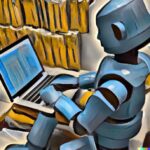The other day, I was talking to my son, who is an executive chef at a senior living facility. We were discussing how much AI has infiltrated his daily work.
“Dad,” he said, “I use ChatGPT and other AI tools all the time. Not just to scale recipes or manage orders, but to research what other senior living facilities are doing to always stay one step ahead, and even to assist me in finding creative ideas for my menus. It’ll pull historical and seasonal pairings so I can design meals my residents actually look forward to.”
As our conversation shifted from how he was already using AI to the bigger idea of what artificial intelligence means in everyday work, I said, “Do you remember when we were driving across the country and stopped in Ohio to check in on the Wendy’s we used to own?”
He laughed. “Yeah, you dragged me into the kitchen.”
“I had the operator take us back there,” I said. “I wanted you to see that two-sided flat top grill. Remember how it cooked burgers in seconds by cooking the top and bottom at the same time?”
“Like a giant panini press for burgers,” he said.
He grinned. “Even back then, I was thinking how that kind of automation could change my industry. And now, if you pair those labor and time savings automations with AI to handle order processing and kitchen flow, you’d barely need line cooks.”
He paused for a moment, clearly worried. He observed that with this kind of AI-informed automation, it might mean fewer new cooks would ever get trained, and wondered aloud where tomorrow’s chefs would come from if the pipeline dried up.
His observation intrigued me. Because the same thing is happening across many industries, not just the food industry. AI-informed automation is eating away at many entry-level jobs, the grunt work that used to be the training ground. My son worried aloud, “If you lose that, what happens to the mastery that comes later?” In response, I explained that while AI can handle tasks far beyond what humans could do quickly, there are just as many things machines still can’t do, and that’s the real point of our conversation. Yes, much of the processing or cooking itself can be automated, reducing labor. But the real magic is at the edges, where someone steps in as the interpreter for AI, the whisperer who translates data into human experience.
The Edges of Automation and AI
I explained that while AI can handle many tasks better and faster than any humans could do, there were just as many things machines still can’t do, and that was the real point I wanted to make. These gaps, the edges where AI and automation fall short, are exactly where opportunity lives.
“Like what?” he asked.
“Taste,” I said. “AI can’t taste your soup and know if it needs more salt. It can’t feel the mood in your dining room or decide to lean toward comfort food on a cold and snowy day. It can’t sense when your residents want something nostalgic instead of something novel. That’s where you come in. You’re the translator. The whisperer between AI’s data and human experience.”
He nodded. “So, you’re saying it’s not just about the tool. It’s about the hands holding it.”
“Exactly. A saw doesn’t build a table. A hammer doesn’t build a house. The tool only becomes valuable in the hands of a craftsman.”
And then I leaned back and added, “That’s not just true for kitchens. Every business needs to explore those edges. Where AI stops and where skilled humans still matter.”
Whisperers in the Real World
Let me pull back from our conversation for a minute, because this isn’t just about food. The opportunity here is for small business owners who understand both their trade and AI. If you can whisper to the tool, you create value that AI alone cannot.
Here are five examples of near-term edges where whisperers win:
1. Food & Hospitality
Consider restaurants, catering companies, hotels, or even retirement communities, such as where my son works. AI can optimize menus, reduce waste, and even forecast what ingredients should be ordered each week. But the whisperer role is in taking all that raw data and transforming it into an experience that customers crave. It’s a chef noticing that residents are nostalgic for pumpkin pie on a fall day, or a restaurateur using AI to highlight profitable dishes but rearranging the menu and plating so it feels comforting instead of corporate. And it’s also the chef who reads the room, senses when the weather outside calls for something warm and hearty, or notices that an external event has shifted the mood of the diners. These are acts of intuition—things AI can’t do very well today. The translator ensures that numbers don’t overpower flavor, tradition, and the human need for connection over meals.
2. Health & Wellness
AI-driven apps can create workout routines or even diagnose patterns in patient data. Yet when someone walks into a physical therapy office or a yoga studio, they’re not just looking for a plan—they want encouragement, touch, and a sense that someone sees them as an individual. Whisperers here use AI’s precision as a guide but build on it with empathy. A personal trainer can use AI to analyze form from video, but it’s their tone of voice and motivation that keep a client coming back. In wellness businesses, the whisperer bridges the gap between sterile recommendations and human healing.
3. Construction & Skilled Trades
Blueprint software and AI-driven design tools are already transforming the construction industry. A program can generate multiple floor plans in minutes or suggest energy-efficient materials. But anyone who has spent a day on a jobsite knows the plan is never the reality. Soil shifts, adverse weather conditions make some efforts impractical, shipment delays occur, orders are received incorrectly, and people get sick or go on vacation. Whisperers in construction are the contractors and tradespeople who use AI as a baseline but make judgment calls in the field. They know how to translate the perfect digital model into something that works in real-world conditions; sometimes improvising with materials on hand or adjusting for quirks in the build. That translation layer is what keeps projects on time and on budget.
4. Education & Training
In education, AI can tutor, grade, and generate content on nearly any subject. But teaching is more than knowledge transfer. A good teacher senses when a student is frustrated, shifts pace, or tells a story that makes an abstract concept click. We are a species that learns from stories, and while an AI can generate a tidy example, it often feels clinical and forgettable. A story drawn from personal experience carries weight, sticks in memory, and gives students something to relate to. Whisperers in this space are the educators who lean on AI to handle repetitive tasks but focus their energy on motivation, inspiration, and context. In corporate training, it’s the facilitator who interprets assessment results, creates dialogue, and sparks peer-to-peer learning—things AI alone can’t replicate. The magic is in blending efficiency with human connection.
5. Business & Advisory Services
AI can analyze spreadsheets, run forecasts, and even simulate different strategic scenarios. But what it can’t do is understand the messy, human realities of business ownership. Whisperers here are the advisors, consultants, and mentors who use AI tools to surface insights but then translate those insights into guidance shaped by lived experience. It’s knowing that a client’s brother-in-law is on the payroll that changes the dynamic. It’s spotting that a financial model looks solid but won’t fly in a particular local market. It’s helping a solopreneur decide not just what’s possible, but what’s wise given their goals and constraints. The whisperer role is in turning analysis into wisdom.
Why Every Business Needs Whisperers
“Dad,” my son said, “so you’re saying the sweet spot is where humans and AI work together?”
“Exactly. The businesses that thrive won’t be the ones who resist AI, and they won’t be the ones who hand everything over to it either. They’ll be the ones who learn to whisper. To take what AI offers and translate it into outcomes customers actually value.”
That’s the carpenter with a saw. The chef with a flat top. Or the mentor with a business analysis report.
And it’s also the insurance policy against losing our pipeline of talent. Because if we let AI strip out all the human parts, who’s left to master the craft?
The General Lesson
The conversation with my son was about food, but the lesson is much bigger. Every business owner should be asking:
- Where does AI shine in my industry?
- Where does it fall short?
- How do I position myself as the human whisperer who makes the tool useful?
The answers will look different in construction than in education, in healthcare than in retail. But the principle is the same.
AI is a powerful saw. But it won’t build the table for you.
That’s the final message I left with my son, and it’s the same message I’ll leave with you: Don’t just look at AI as a replacement for people. Look at it as a tool. Then figure out how to be the whisperer who turns that tool into something customers value.
Because that’s the edge where opportunity lives.
Where in your business could you step into the whisperer role—bridging AI’s capabilities with the human touch your customers can’t live without?












